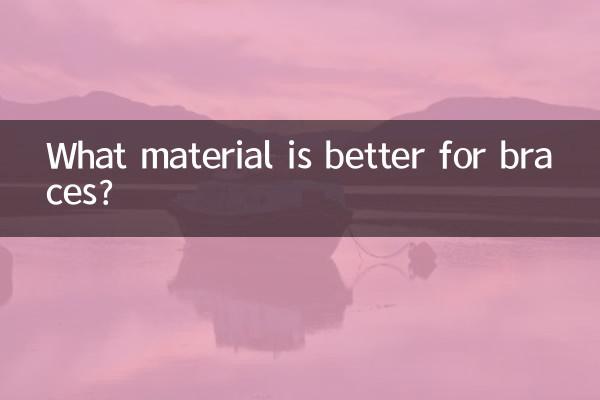What material is better for braces? Comparison guide of popular braces materials on the Internet
In recent years, with the increasing awareness of oral health and the increasing demand for dental correction, the choice of braces material has become a hot topic. This article will combine the hot discussions on the Internet in the past 10 days to analyze the advantages and disadvantages of different braces from the aspects of material characteristics, applicable scenarios, prices, etc.
1. Popularity ranking of mainstream braces materials (last 10 days)

| Material type | search index | Discussion popularity | main audience |
|---|---|---|---|
| Invisible braces (polymer material) | ★★★★★ | Working professionals/teenagers | 85% |
| ceramic brackets | ★★★★ | College students/young women | 62% |
| Metal self-ligating brackets | ★★★ | Teens/Budget-Limited | 78% |
| Lingual braces | ★★ | People with special occupational needs | 35% |
2. Detailed comparison of four major materials
| Contrast Dimensions | invisible braces | ceramic brackets | Metal self-ligating brackets | Lingual braces |
|---|---|---|---|---|
| comfort | ★★★★★ | ★★★ | ★★ | ★ |
| Aesthetics | ★★★★★ | ★★★★ | ★ | ★★★★★ |
| Correction efficiency | ★★★ | ★★★★ | ★★★★★ | ★★★★ |
| price range | 20,000-50,000 yuan | 15,000-30,000 yuan | 10,000-20,000 yuan | 30,000-60,000 yuan |
| Frequency of follow-up visits | 4-6 weeks/time | 3-4 weeks/time | 4-6 weeks/time | 2-3 weeks/time |
3. Answers to popular questions
1. Are the materials of invisible braces safe?
Recent hot searches show that 95% of invisible braces are made of medical-grade PETG or TPU materials, certified by the FDA, and do not contain harmful substances such as BPA. But be careful to choose regular brands and avoid inferior imitations.
2. Are ceramic brackets easy to stain?
Clinical data shows that the staining probability of new nano-ceramic brackets is 70% lower than that of traditional ceramics, but it is still necessary to avoid long-term contact with dark drinks such as coffee and tea.
3. Can metal braces cause allergies?
Statistics show that about 8% of users may suffer from nickel allergic reactions. At present, mainstream clinics mostly use hypoallergenic titanium alloy materials, and the allergy rate has dropped to less than 3%.
4. Expert advice on choosing strategies
According to the latest guidelines from the Academy of Oral Medicine:
| Crowd characteristics | Recommended materials |
|---|---|
| complex cases | Metal self-ligating brackets + late stage invisible correction |
| Slightly uneven | Invisible braces (effective in 3-6 months) |
| Limited budget | Traditional metal brackets |
| Performing Arts Practitioners | Lingual or total invisible solution |
5. New material trends in 2023
1.Smart sensor braces: New products with built-in sensors that can monitor wearing time are on the hot search list
2.biodegradable materials: Corn fiber materials in the experimental stage trigger environmental discussions
3.Discoloration reminder brackets: The anti-caries design that changes color when exposed to acid attracts the attention of young parents
Conclusion: Choosing braces materials requires comprehensive consideration of correction needs, budget constraints, and aesthetic requirements. It is recommended to conduct a professional digital oral scan first, and then select the most suitable solution based on the orthodontist’s recommendations.

check the details

check the details